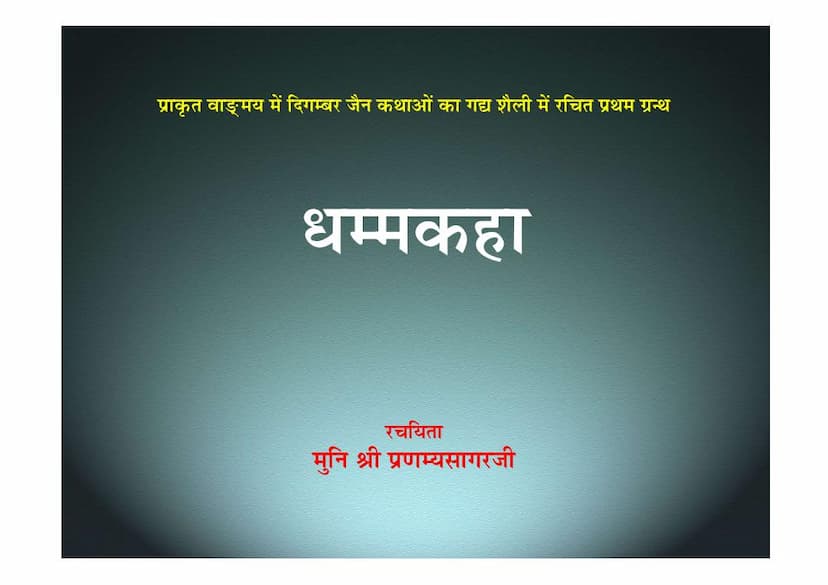Dhamma Kaha
Added to library: September 1, 2025

Summary
The book "Dhamma Kaha" by Muni Shri Pranamyasagar, published by Akalankdev Jain Vidya Shodhalay Samiti, is a collection of Jain stories presented in prose style. It is stated to be the first such work in Prakrit literature.
The book is divided into two sections:
First Section: Pauranik Kathayein (Mythological Stories) This section comprises 24 individual stories, each detailing moral and ethical lessons through narratives of historical and exemplary figures. The included stories are:
- Anjan Chor Katha (The Story of Anjan the Thief)
- Anantmayi Katha (The Story of Anantmayi)
- Uddhayan Ray Katha (The Story of King Uddhayan)
- Revati Rani Katha (The Story of Queen Revati)
- Jinindabhakt Seth Katha (The Story of the Devotee Seth Jinendra)
- Varisen Muni Katha (The Story of Muni Varisen)
- Vihnu Kumar Muni Katha (The Story of Muni Vishnu Kumar)
- Vajra Kumar Muni Katha (The Story of Muni Vajra Kumar)
- Jamval Chandal Katha (The Story of Jamval the Chandala)
- Dhanadev Katha (The Story of Dhanadev)
- Nili Katha (The Story of Nili)
- Jay Kumar Katha (The Story of Prince Jay)
- Dhanasri Katha (The Story of Dhanasri)
- Sachghosh Katha (The Story of Sachghosh)
- Tapas Katha (The Story of the Ascetic)
- Jamdand Kottapal Katha (The Story of the Gatekeeper Jamdand)
- Samassunavanita Katha (The Story of Samassunavanita)
- Shrisen Raja Katha (The Story of King Shrisen)
- Vasasen Katha (The Story of Vasasen)
- Kondesh Katha (The Story of Kondesh)
- Suyar Katha (The Story of the Pig)
- Bhegass Katha (The Story of the Frog)
- Sukosal Muni Katha (The Story of Muni Sukosal)
- Chanakk Muni Katha (The Story of Muni Chanakk)
Second Section: Shodah Karan Bhavana Kathayein (Stories of the Sixteen Vows/Emotions for attaining Salvation) This section contains stories that illustrate the practice and importance of the sixteen essential spiritual practices or emotions that lead to the attainment of liberation (moksha). The introductory part of this section emphasizes that these Bhavanas are indicative of a soul's striving for purification and are crucial for attaining the four purusharthas (righteousness, wealth, desire, and liberation). The text highlights that the practice of these Bhavanas, particularly the highly auspicious ones, can lead to the binding of the Tirthankar Prakriti. The section further elaborates on the philosophical underpinnings of these Bhavanas, their classification, and their significance in the Jain path. The specific Bhavanas covered in this section are:
- Darshan Vishodhi Bhavana (Purity of Perception)
- Vinay Sampannata (Fullness of Humility/Respect)
- Shilavratesu Anatiyar Bhavana (Undefiledness in Vows and Virtues)
- Abhikshnanaovayoga Bhavana (Constant Awareness and Attention)
- Samveg Bhavana (Spirit of Renunciation and Urgency for Liberation)
- Saktie Tyaga Bhavana (Renunciation through Power/Capability)
- Saktie Tapa Bhavana (Asceticism through Power/Capability)
- Sahusamaadi Bhavana (Equanimity and Peace among Monks)
- Vayavachcha Karana Bhavana (Service and Care for the Worthy)
- Arihanta Bhakti Bhavana (Devotion to the Arihantas)
- Acharya Bhakti Bhavana (Devotion to the Acharyas)
- Bahusruta Bhakti Bhavana (Devotion to the Scholars of Scripture)
- Pravachana Bhakti Bhavana (Devotion to the Teachings/Preachings)
- Avashyakaparihina Bhavana (Fulfillment of Essential Duties)
- Margapravana Bhavana (Propagation of the Path)
- Pravachana Vatsalya Bhavana (Affection for the Teachings/Followers)
The book emphasizes the importance of stories and examples from Jain tradition, citing revered Acharyas like Samantabhadra, Kundakunda, Virsen, and Jin-sen, who used narratives to expound Jain principles. It positions these stories, particularly those from the Prathamanuyoga (First Inflow/Primary Teaching), not as mere tales for the unintelligent, but as profound sources of spiritual guidance and treasures for attaining wisdom and peace. The work aims to purify the mind, speech, and actions, while also contributing to the growth of Prakrit literature.